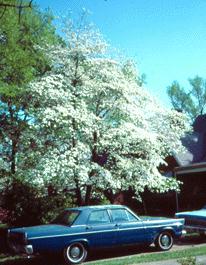Flowering Dogwood
|
|
| Flowering Dogwood | ||||||||||||||||
|---|---|---|---|---|---|---|---|---|---|---|---|---|---|---|---|---|
 Flowering Dogwood in flower | ||||||||||||||||
| Scientific classification | ||||||||||||||||
|
The Flowering Dogwood (Cornus florida or Benthamidia florida) is a showy small tree native to eastern and southeastern North America, where it is also one of the most popular of all small ornamental flowering trees. Like most dogwoods, it has opposite, simple leaves. The tree is extremely showy when in flower, but what people assume to be the flowers are actually showy bracts below the cluster of inconspicuous yellow-green flowers.

While most of the wild trees are white-flowering, some selected cultivars of this tree also have pink flowers, some even almost a true red. They typically flower in early April in the southern part of their range, to late April or early May in northern and high altitude areas. The similar Kousa Dogwood (Cornus kousa), native to Asia, flowers about a month later. Like all dogwoods, Flowering Dogwood produces clusters of green berries which ripen to a bright red in the autumn; they are eaten by birds which distribute the seeds. The berries are edible, though lacking in any interesting flavor. The leaves are opposite, simple acute oval, apparently entire (actually very finely toothed, under a lens), and 6-13 cm long and 4-6 cm broad; they turn a rich red-brown in autumn.
Flowering Dogwood does best horticulturally when it has shade from the west but has good morning sun. It does not do well when exposed to intense heat sources such as adjacent parking lots or air conditioning compressors.
It is very susceptible to dogwood anthracnose, a disease caused by the fungus Discula destructiva. This has killed many wild stocks of Flowering Dogwood; domestic landscape plantings have often been less badly affected because better air circulation and less humid conditions discourages the fungus, but losses still occur frequently. The Kousa Dogwood is resistant to this disease.

